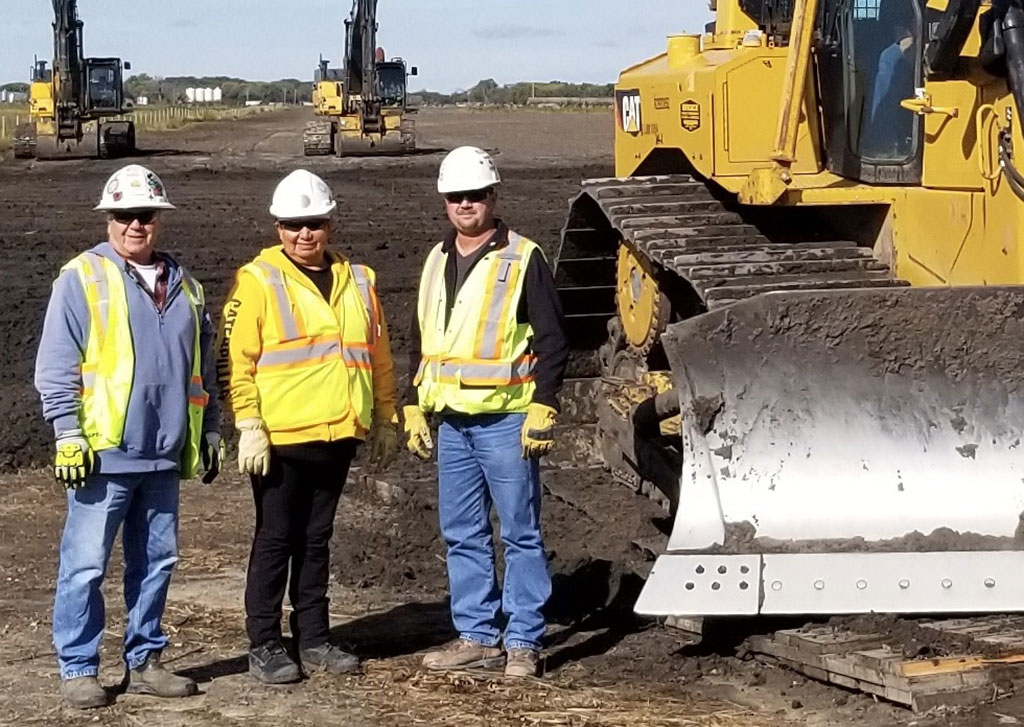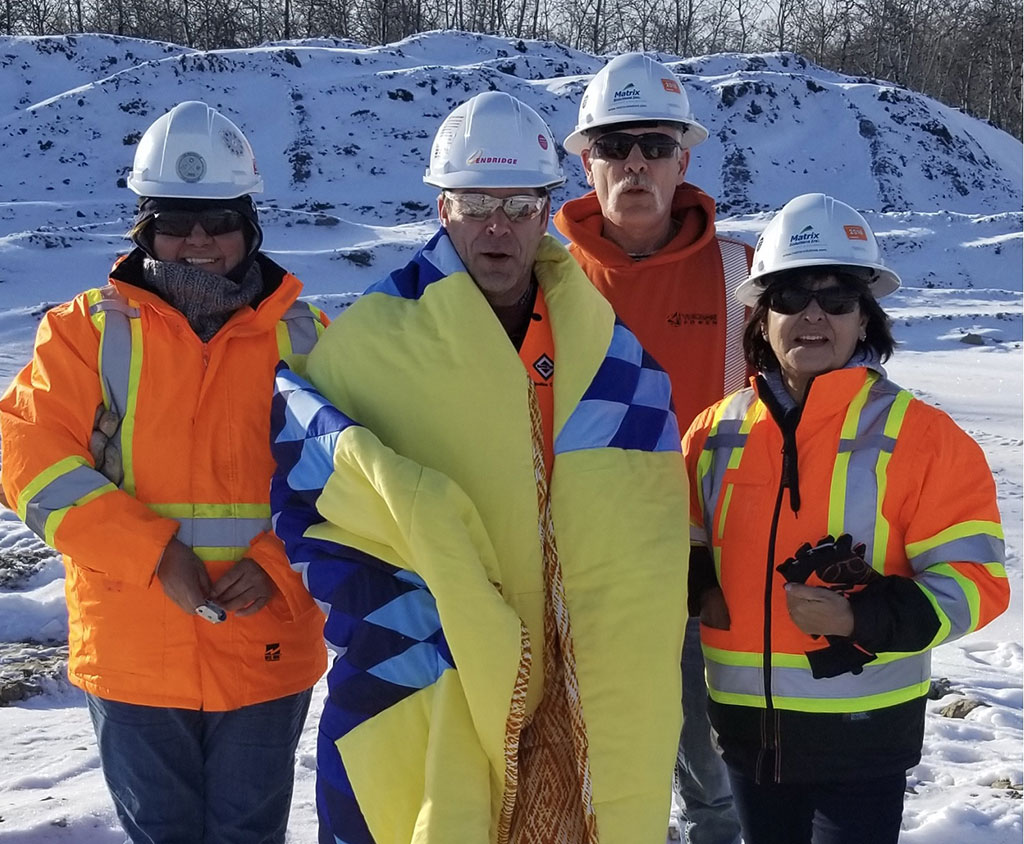The Business of
Reconciliation
In 2015, the report of the Truth and Reconciliation Commission called upon Canada’s corporate sector
to adopt UNDRIP as a reconciliation framework.
Did they listen?
By Graham Chandler

In 2008 as part of the Indian Residential Schools Settlement Agreement, Ottawa launched the Truth and Reconciliation Commission (TRC). Intended as a process to reveal the facts behind the residential school system, the TRC also laid the foundation for a lasting reconciliation. Final reports were released in 2015.
Among the 2015 reports’ comprehensive list of calls to action was one aimed squarely at Canada’s corporate sector. Labeled Item 92, it called upon them “to adopt the United Nations Declaration on the Rights of Indigenous Peoples (UNDRIP) as a reconciliation framework and to apply its principles, norms, and standards to corporate policy and core operational activities involving Indigenous peoples and their lands and resources.” Three specific areas were detailed in Item 92: (i) meaningful consultation, (ii) equitable access, and (iii) education for management and staff.
It has been five years now. How have companies reacted to the calls and what actions have they spurred?

ENBRIDGE
“At that junction it was a catalyst for us to do better, to do more,” says Kim Brenneis, Enbridge’s Director, Community and Indigenous Engagement in Canada. Acting on the three calls, they reviewed what they had at the time – called their Aboriginal Native American Policy – and replaced it with the new Indigenous Peoples Policy. “These are our key principles that guide our relations with Indigenous peoples. Its principles recognize UNDRIP within the context of Canadian and U.S. law,” he says. “We were one of the first to recognize that document. It’s the cornerstone of the work we do here at Enbridge.”
The $5.3-billion Canadian portion of the company’s Line 3 Replacement Program which began commercial service in December 2019 serves as a good example of application of the new policy. “It’s a good example of where that evolution took place,” says Brenneis. “It gave us an opportunity to really grow those relationships with communities along the right of way and that call for action Item 92 is to make sure that you are including them in a partnership not only for meaningful engagement but also an economically meaningful economic inclusion.”
But it isn’t just one place. “We have relationships with over 200 communities in Canada with many different projects across the country, and those standards and that approach are guided in part by what came out of the TRC across Canada,” he says.
Brenneis expands upon Enbridge’s progress in each of the three areas detailed under Item 92. “We are committed to meaningful consultation about building relationships. This isn’t transactional. It’s not ‘here today gone tomorrow’ by any means. It’s very much a relationship. I think we’ve always consulted but certainly, our approach has evolved, developed, and deepened over the last five years. In part it’s influenced by the calls to action. We believe our approach is consistent with UNDRIP.”
On meaningful consultation, for example, they had heard for years communities’ concerns of how do we know our interests are thoughtfully considered and taken care of? To address that, after Item 92 they developed an Indigenous monitoring program on the Line 3 build. “We hired monitors from three independent Indigenous companies that represented all 154 communities we spoke to,” explains Brenneis. “Their report went to the regulator and to the communities and was integrated into our construction team. They were involved in every step of the way, including how to manage sensitive cultural sites. They were an integral part of the construction project.”
Secondly, Indigenous project spending, including labour and contracting, capacity building and community sustainability initiatives totaled $465 million over the two-year construction period says Brenneis. Of which $148 million in wages went to over 1,100 Indigenous men and women. “They comprised 20% of the workforce and that $148 million went into their pockets, much of which went to their communities and families.”
That wasn’t the end. As well, for Indigenous workers’ success beyond the construction period, training and education that provides opportunities to realize long-term, sustainable benefits are provided. A total of 260 Indigenous men and women graduated from Enbridge’s Pipeline 101 training-to-employment program giving them the important skills for pipeline and similar industrial project work.
For the third principle of Item 92, education, “we’ve had a formal program in place since 2016 both online and in-person training,” says Brenneis. “Over 1800 employees and contractors have completed that training already and it continues to grow and gain momentum.”
And Item 92 has fundamentally influenced the company’s approach towards engagement and relationships on a life cycle he says. Indigenous engagement is now closely tied to the asset’s life cycle. “We have assets that are in the ground and have been for decades, and will be for more decades. We have a responsibility and an opportunity to have a relationship with communities for the life of those assets – how we deal with communities about the important things in the operational context like emergency response, maintenance activities, how you operate a pipeline.”

AGNICO EAGLE MINES LIMITED
“It was long overdue, I think it was recognition of Canadians like you and I that something was wrong from the time we enacted those laws of the time and some correcting was needed,” says Patrice Gilbert, Agnico’s Vice President Health, Safety, Social and Public Affairs.
“As to UNDRIP and the TRC report, and specifically the Item 92 calls to action we became very aware of them when we were starting to engage in discussions with First Nations in Quebec and Ontario in 2015. That’s when we specifically started on those consultations relative to the calls to action.”
The company’s policy is now aligned with the three articles of Item 92. “For number iii [education] for example, we adopted that in our first policy in 2016 when we worked with leaders from the Timiskaming First Nation,” says Gilbert. “We put together a training and cultural sensitivity program where that rep had the opportunity to train 80 to 100 leaders of our company.”
One was held in Toronto for senior managers and employees who may have to interact with Indigenous people. Others trained 50 company leaders in Abitibi, Quebec in the Goldex mine there.
The courses are comprehensive and thoughtful. “We have an Anishinaabe teacher,” says Gilbert. “We talk about the history as well as all the challenges of going through as a First Nations person, the social adoption, the recognition of your children. We learn about the residential schools. The way she was teaching us was not insisting on the negative side of it; it was more to inform us about resilience like they had used the land for thousands of years and were able to survive on it. And we understood as well the battles and the fights that we are going through for the recognition of lands.”
It was all in line with UNDRIP principles. To ensure that compliance was monitored and continued, they formed a corporate team with three coordinators and dubbed it the Indigenous Relations Team.With a sizeable contingent of Indigenous workers, they considered that to be important. “We have about 2,500 employees in Quebec and about 2,500 in Nunavut,” says Gilbert. “And in Nunavut between 30% and 35% of our permanent employees are Aboriginal, so we recognize that if we want to sustain our acceptability, having the support of [Indigenous peoples] is so important.”
So important in fact, that he thinks some thought should be given to providing Indigenous people a share of the resource royalties. “We want to make sure they are highly regarded, both locally and internationally.”
“In Kirkland Lake, Abitibi, and Nunavut we are very pleased with the progress we’ve made and if the TRC report was a trigger for that I think it was a good thing for us,” he says. “Because we believe that for success in the long term as a mining company we need to have the social acceptability of both the community government and also the First Nations.”
“In Kirkland Lake, Abitibi, and Nunavut we are very pleased with the progress we’ve made”
MOSAIC FOREST MANAGEMENT

“I would say that the 2015 Truth and Reconciliation Commission Report crystallized our respect for the rights of Indigenous peoples through all corners of our business,” says Ken Price, Manager Partnerships for Mosaic Forest Management.
Mosaic decided to comply via a corporate commitment to become certified in Progressive Aboriginal Relations, or PAR, through the Canadian Council for Aboriginal Business (CCAB). [Refer to heading below for more on PAR.]
“That required leadership commitments, employment, business, and community relations,” says Price. “And in 2017, after we established the lead on that program, we took all our past packages, formalized them to the PAR commitment and incorporated those into our corporate strategy. Our CEO signed off on what was, at that time, our First Nations Relations Policy. It’s now formalized as the Mosaic Indigenous Relations Policy.”
The Policy addresses the three principles of Item 92. For (i), “we do what’s called Information Sharing on the Crown lands we manage,” explains Price. “We provide First Nations that have overlapping territories with our operations, the information required for them to have a level of knowledge to be comfortable for these operations. In some of our private operations, we have a Nation-to-business understanding. So for those Nations wishing to foster deeper, broader and more enduring relationships, we formalize through an MoU and provide the information.”
Secondly, for (ii), equitable access is assured. All of the fieldwork – cutting down the tree, processing it into logs,
and planting a tree – is contract work under an open bid process. “Each and every Nation has the opportunity to bid on projects,” says Price. “
And that is also a big part of our PAR certification as well. If two contractors had equal bids we would award the contract to the First Nations applicant.” For (iii) training, “we provide it as applied to the work they are looking for. We work hard to communicate what’s required to band offices and their business managers; what is needed to pre-qualify. When we have been informed where their gaps are we will work with them to provide the opportunity to get that training before the work needs to start.” Further, Mosaic is a member of the BC Business Council. “Our CEO sits on the leadership council and we have committed to provide internships. I think we are the first ones in the forest sector to bring interns into our business areas – ranging from cruising to silviculture – a very broad cross-section of operational planning.”
Cultural training extends to management and staff. All staff except recent hires have completed cultural sensitivity training and Indigenous corporate training to a level based on their position’s interaction. One is Indigenous awareness training which goes through industry and calls to action workshops for providing the history of First Nations, including residential schools. “And all our executive and decision-makers go through the ‘working effectively with indigenous peoples’ training,” he says. “As well, new hires have 30 days to complete our online training program. We are currently designing an online refresher for our staff – it’s on my to-do list for 2020.”
It’s not without its challenges. “We are focused on formalizing a tracking system,” says Price. “To show we are honoring our commitments and making sure that we articulate our commitments out to the broader public and all our communities – both First Nations and non-First Nations – to show what we have done.”
NATIONAL CENTRE FOR TRUTH AND RECONCILIATION
Three corporations, three impressive reactions to the TRC calls. Are they representative of the wider field performance? The National Centre for Truth and Reconciliation (NTCR) was formed in 2015 primarily to archive all materials gathered by the TRC. It was also officially mandated to maintain follow-up actions such as monitoring TRC’s calls to action, including those directed to the corporate sector.

Unfortunately, progress on monitoring corporate sector compliance has been slow. “Generally speaking when it comes to monitoring the calls to action we remain in a bit of a gap situation right now,” says Ry Moran, NCTR’s director, “wherein the call to form the NCTR hasn’t really been fully realized.”
Nevertheless, Moran is ready to elucidate many anecdotes showing progress in Indigenous relations by the corporate sector. “If we look at what has been happening here in Winnipeg I think there are a number of extremely positive steps that are being taken by a wide range of businesses,” he says. “Being championed by organizations like United Way there are regular Call to Action 92 breakfast meetings that are happening. Regular interactions between businesses and NCTR are developing to further enhance staff training plans on a whole variety of issues, and are really taking that call to action very seriously.”
“Here in Winnipeg we get this window as to what is happening in the rest of the country,” he says. “Look at the Winnipeg Jets, which is ultimately a business. They are doing some really exciting things like creating this thing they call Wasatch night celebrating Aboriginal sports; they’ve created a specific Indigenous-designed Jets logo which is now part of the merchandise they’ve rolled out. They’re incorporating Indigenous singers and performers in their opening ceremonies and on special nights. That’s really important because of course all businesses have a choice of what to do and what not to do. And that’s happening across the NHL generally – a number of other teams are doing similar things.” He also notes the Asper School of Business at the University of Manitoba is taking Call to Action 92 very seriously. It’s adopting an ambitious and visionary strategic plan soon ready to roll out that will focus on ensuring Call 92 and beyond are incorporated in business education.
And from his own experience teaching a program called ‘Truth and Reconciliation through Regulations’ at the Banff Centre for Arts and Creativity for the past three years he’s seen a broad cross-section of people attending, especially from the business community. “So the corporate sector is recognizing the need to provide training to their employees through attending programs like that. It’s a positive sign the sector is alert to that.” Moreover, he sees an increasing number of businesses approaching the NCTR looking to better understand Indigenous history, like what happened at residential schools. “We have been helping,” he says.
“Certainly your major employers – especially where there is interaction with Indigenous peoples – are recognizing that they have an obligation and requirement to both provide employment to Indigenous peoples and to educate staff.” Finally, Moran notes the huge growth of Indigenous businesses across Canada. “That is a significant part of economic reconciliation,” he says.
CANADIAN COUNCIL FOR ABORIGINAL BUSINESS
Another window into the corporate sector’s progress per Item 92 comes from the Canadian Council for Aboriginal Business (CCAB).
“We have definitely seen an increase in our membership and I think that is partially attributable to the TRC 92,” says Tabatha Bull, Chief Operating Officer. “Even since I joined here a year and a half ago it’s gone from 700 to close to 1,000. We are seeing increases in both Indigenous and non-Indigenous businesses of close to 30% year over year.”
Bull notes its diversification. “We have numbers now from sports organizations like the Hamilton Tiger Cats of the CFL. And from tech organizations like Amazon and e-bay – those not necessarily in the vicinity of their work but want to better understand what they can do with Indigenous communities. That really harkens back to TRC 92.” Much of the attraction for new members is a CCAB program called Progressive Aboriginal Relations (PAR). It’s a certification program that confirms corporate performance in Aboriginal relations at the Bronze, Silver, and Gold Levels. Certification provides a high level of assurance to communities because the designation is supported by an independent, third-party verification. And the final level is determined by a jury of Indigenous business people.
“Many companies come to us interested in the PAR program and that is directly tied to TRC 92,” says Bull. “Over a hundred are in the program with 36 certified and the remainder in the commitment process. We have trained over 200 just in the past year on the process.”
She reckons it’s not just for reconciliation: they realize Indigenous relations are simply good business. “If you look at investment and outcomes for businesses that are high-scoring on ESG (environmental, social, and governance) criteria, they often have a good track record on their financial statement. In attracting investors too. And I think the great thing about the PAR program is that it is a certification program – an independently verified program – that often provides a step and a profile for organizations that want to take on steps to reconciliation.”
Many corporations commit to long term sustainable benefits from economic development projects – part of Item 92 – through procurement from Indigenous businesses. “In Alberta’s oil and gas sector alone there is over $1.8 billion in business going to Aboriginal businesses annually,” says Bull. “Syncrude and Suncor are both Gold-certified. Syncrude has over $300 million and Suncor over $700 million spent. And Ontario Power Generation, the largest in the province, are Silver-certified; they have three equity partnerships with Indigenous communities.”
CHALLENGES AND THE ROAD AHEAD
As progressive as the companies interviewed and discussed above are, fully conforming with Item 92 is not without its challenges. One that many still face is retention of Indigenous employees, particularly post-project. “Like companies that build work camps for new projects – they are struggling with how they can keep those employees in jobs once the project build is done,” says Bull. “When they leave, the people in the community want to stay. That can be a challenge.”
But she thinks the biggest challenge – as it is for all Canadians – remains an “unconscious bias from not being educated in First Nations history.” NCTR’s Moran concurs on both challenges. “Generally speaking when we talk about UNDRIP and the history of residential schools, even Indigenous identities, people still remain at the outset of their journey.”
Moran says it’s critical that employers aren’t just focused on getting people in the door but ensuring that once they are in the door they’re going to feel comfortable, supported, and able to stay. “And without sacrificing the expectations of their communities or portions of themselves as Indigenous peoples,” he says. “It’s a big issue now; a lot of corporations are struggling because they find their environment is not quite as conducive to Indigenous people succeeding as they might have thought.”
So, in summation, excellent progress so far by the corporate sector in adopting to UNDRIP and Item 92. “All very positive things,” concludes Moran. “But there is a lot of ground we still need to cover.” ABQ

